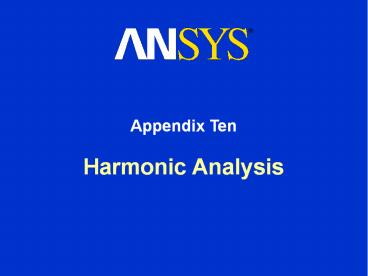Harmonic Analysis - PowerPoint PPT Presentation
Title:
Harmonic Analysis
Description:
Appendix Ten Harmonic Analysis – PowerPoint PPT presentation
Number of Views:152
Avg rating:3.0/5.0
Title: Harmonic Analysis
1
Harmonic Analysis
- Appendix Ten
2
Background on Harmonic Analysis
- Separation of real and imaginary terms can be
performed for not just the force loading but also
the response - If the harmonic loading and response are
substituted back in the equation of motion, the
following is obtained
3
Loads and Supports (ANSYS)
- Internally, loads are applied slightly
differently than in an equivalent static
analysis - Forces on vertices and edges are applied as real
imaginary nodal loads via F,,FX/FY/FZ,REAL,IMAG - Pressures and Forces on surfaces are applied on
surface effect elements SURF154 with KEYOPT(11)2 - For Pressure Load, input is via
SF,,PRES,REAL,IMAG - For Force Load on surface, input via
SFE,,5,PRES,0 for real and SFE,,5,PRES,2 for
imaginary components - Given Displacement Support is via
D,,UX/UY/UZ,REAL,IMAG - Acceleration, Bearing, and Moment Loads are used
as normal - Bearing loads are applied as SFE on face 5 of
SURF154. Two sets are created for axial and
radial components of bearing load Axial uses
KEYOPT(11)2, Radial uses KEYOPT(11)0 - Moments on vertices or edges of shells are
applied as nodal loads via F,,MX/MY/MZ while
moments on surfaces are applied via CONTA174
surface-based constraint (see Ch. 4)
4
Mode Superposition Method
- The previous two equations can be combined and
pre-multiplied by the mode shape fiT - Although outside of the scope of the discussion,
the above equation reduces to the following - The resulting equation is uncoupled and is easier
to solve - The total degrees of freedom are not dictated by
the number of nodes in the mesh. Instead, it is
determined by the number of modes n used in the
equation. - The equation is simplified because of the
following properties - Normalization of M
- Natural frequency wi for mode i
- Damping ratio xi for mode i
5
Mode Superposition (ANSYS)
- The ANSYS mode superposition method is run
internally - A modal analysis is run first with Block Lanczos
eigenvalue extraction method (MODOPT,LANB,200,FREQ
B/2,2FREQE) - A maximum of 200 modes between ½ of the beginning
frequency FREQB to 2 times the ending frequency
FREQE is solved for - A load vector is automatically created at this
time - A harmonic analysis using mode superposition
method (HROPT,MSUP) is then performed - Frequency range specified with HARFRQ,FREQB,FREQE
- If clustering is requested, HROUT,,ON is issued
- All loads are step-applied in the frequency range
(KBC,1) - Number of intervals (or cluster number) specified
with NSUBST - Load vector of 1.0 is issued with LVSCALE,1
- OUTRES with nodal and element components used
- An expansion pass is also performed for contour
results - EXPASS,ON and HREXP,ALL are used
6
Full Method (ANSYS)
- Internally, the Full method is used in ANSYS
- Frequency range specified with HARFRQ,FREQB,FREQE
- HROPT,FULL is used
- Number of intervals specified with NSUBST
- Loads are step applied in frequency range with
KBC,1 - The equation solver is the default sparse solver.
The Details view of the Solution branch has no
effect on full harmonic analyses, as no solver
command (EQSLV) is issued - OUTRES with nodal and element components used

